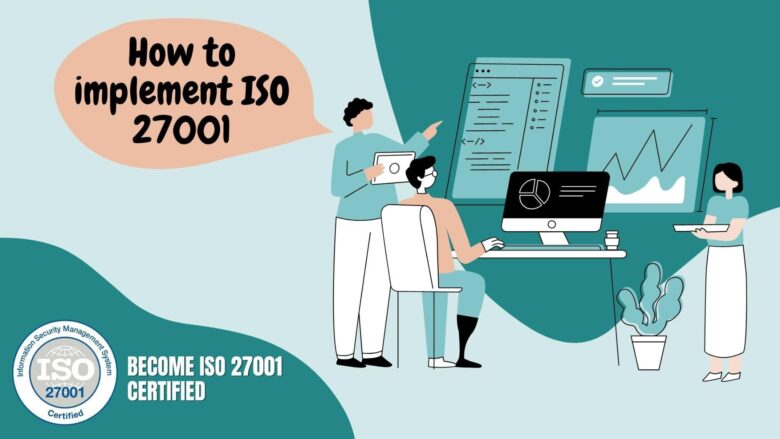An Information Security Management System [ISMS] must comply with the standards of ISO 27001, which is an international standard. An ISMS is a methodical strategy for handling critical enterprise data in a secure manner. In today’s age of cyber threats, where there is a high danger of information breaches, ISO 27001 is becoming more and more significant.
When an Organisation adopts ISO 27001, they can be sure that they have created a thorough framework for information security that adheres to industry best practices. By putting the Standard into practice, Organisations may safeguard their standing, prevent financial losses, and adhere to legal and regulatory obligations. It’s also important that they understand iso 27001 certification cost factors as well.
In this article, we will give a quick rundown of the things to consider for ISO 27001 implementation. We will go over the essential procedures for putting an ISMS into place, from doing a gap analysis to getting ISO 27001 certified. We hope that this article will clarify the importance of ISO 27001 for you and give you instructions on how to use it to your Organisation.
Pre-implementation phase
Before an Organisation can start implementing ISO 27001, it needs to go through a pre-implementation phase that involves several key steps.
Conducting a gap analysis to identify areas of improvement:
To find areas for improvement, a gap analysis is the first stage in the pre-implementation phase. An evaluation of an Organisation’s present information security practices and policies in comparison to ISO 27001 requirements is known as a gap analysis. This study aids the Organization in locating any security procedures and policies that require improvement.
Reviewing current information security-related policies, practices, and controls will be part of the gap analysis. The analysis should also take into account the Organisational goals, legal requirements, and risk tolerance. A list of areas in need of improvement to meet ISO 27001 requirements will emerge from the gap analysis.
Building a business case for implementation:
Building a business case for implementation is the next stage after the gaps have been found. This entails drafting a thorough plan that details the expenses and advantages of putting ISO 27001 into practise. The risks of not adopting the Standard should also be highlighted in the business case.
The resources required for achieving compliance with the Standard, such as staff, technology, and training, should be covered in the business case as well. It should include any possible cost savings, efficiency, or revenue growth and offer a realistic estimate of the costs and advantages connected with putting ISO 27001 into practice.
Selecting a project team and assigning roles and responsibilities
The selection of a project team and the distribution of roles and duties are the last steps in the pre-implementation phase. The project team should be made up of people who have the required expertise, training, and knowledge to implement ISO 27001.
A project manager who will be in charge of supervising the implementation procedure should be in charge of the project team. To guarantee that the project is finished on time, within budget, and to the requisite standard, the project manager should collaborate closely with the business and technical stakeholders.
Each team member should be given roles and duties according to their knowledge and skill set. This will guarantee that every team member is aware of their responsibilities and dedicated to completing their portion of the project. For the implementation of ISO 27001 to be successful and satisfy the goals of the Organization, the project team should collaborate closely with the business and technical stakeholders.
Organisations can make sure they are well-prepared for the implementation of ISO 27001 by taking these actions during the pre-implementation phase. This will make it more likely that the standard will be successfully implemented and that the Organization will receive all of its benefits.
Implementation phase
An Organisation may proceed to the implementation phase after finishing the pre-implementation phase. There are numerous crucial milestones in this phase:
Establishing an Information Security Management System [ISMS]
The creation of an Information Security Management System [ISMS] is the first action taken during the implementation phase. The Organisation will manage its information security risks using the ISMS as a framework. The ISMS should be customised to the needs of the Organization, taking into account the Organization’s business goals, risk tolerance, and regulatory requirements.
Conducting a risk assessment and implementing risk treatment plans
The next stage is to conduct a risk assessment to determine and assess the information security risks to the Organization. The information obtained during the pre-implementation phase, such as the gap analysis and the business case, should serve as the foundation for the risk assessment.
The Organization should implement risk treatment plans to address the risks once they have been identified. The likelihood and impact of the identified risks should be lessened by the risk treatment measures. The Organization’s risk appetite and the resources available to address the risks should both be taken into account in the risk treatment programmes.
Developing policies, procedures, and guidelines to support the ISMS
To support the ISMS, the Organization should create policies, processes, and guidelines. These documents should be based on ISO 27001 specifications and customised to the needs of the Organization. All facets of information security management, such as access control, incident management, and business continuity, should be covered by the policies, procedures, and guidelines.
Training employees on information security best practices
In the implementation of information security, employees are one of the most essential resources. As a result, the Organisation needs to teach its staff on best practices for information security. Data protection, phishing awareness, and password management should all be covered in the training. In order to keep staff members informed of the most recent information security best practices, the Organisation should also set up an ongoing training programme.
Establishing and monitoring performance metrics
Finally, the Organisation needs to develop performance indicators to gauge how well the ISMS is working. The performance metrics ought to be based on the ISMS’s goals and adjusted to the particular requirements of the Organization. To make sure that the ISMS is accomplishing its goals, the Organisation should analyse and monitor the performance metrics on a regular basis.
Organisations can develop a solid Information Security Management System that complies with ISO 27001 requirements by following these steps throughout the implementation phase. By doing so, the Organization will be better able to maintain the confidentiality, integrity, and availability of its sensitive data and be safeguarded against information security risks.
Post-implementation phase
Just like the earlier phases, the post-implementation phase is quite important. In order to maintain the ISMS’s effectiveness and applicability, it demands regular monitoring and improvement. These are some crucial actions to think about at this phase:
Conducting regular internal audits to ensure compliance
To make sure that the ISMS is operating as planned and in compliance with ISO 27001, regular internal audits are required. All facets of the ISMS should be examined during the internal audit, which should be carried out by a qualified and independent individual. Any non-conformities and areas for improvement should be found during the audit, and the necessary corrective measures should be taken afterward.
Continuously improving the ISMS through monitoring, review, and updating
For the ISMS to continue to be useful and effective, it must be regularly examined, updated, and monitored. This entails staying current on Organisational changes, the threat environment, and legal obligations. A procedure for managing changes to the ISMS, including reviewing and updating policies, procedures, and guidelines, should be established by the Organisation.
Preparing for certification audit and maintaining certification
If the Organization wants to be certified, it must undertake a pre-audit to find any gaps and non-conformities before the certification audit. The certification audit will evaluate the Organization’s adherence to ISO 27001, and the Organization must be ready to provide paperwork and proof of conformity.
Once the Organization has been certified, it should keep it by performing routine surveillance audits and re-certification audits. Although the re-certification audit will evaluate the ISMS’s compliance over a three-year period, the surveillance audits will evaluate the ISMS’s ongoing compliance.
Organisations can make sure that the ISMS stays functional and in compliance with ISO 27001 by taking the procedures outlined here during the post-implementation phase. Building confidence with clients, partners, and stakeholders will be made easier as a result of maintaining the sensitive information’s confidentiality, integrity, and availability.
Conclusion
Information security is essential to an Organisation’s performance and long-term viability in today’s digital world. An Information Security Management System [ISMS] can be created, implemented, maintained, and improved using the framework provided by ISO 27001. The ISMS assists Organizations in recognising and controlling their information security risks and in preserving the privacy, accuracy, and accessibility of their sensitive data.
The Organisation’s leadership must be committed to implementing ISO 27001, and all workers must be involved. Pre-implementation, planning and implementation, post-implementation, and certification are its four main phases. Organisations can create a successful and compliant ISMS that satisfies their particular needs and requirements by adhering to these phases and the processes described in this article.
Organisations can gain from implementing ISO 27001 by having better information security, more confidence from stakeholders, partners, and customers, and compliance with legal obligations. Also, it aids Organisations in reducing the dangers of information security incidents, data breaches, and other cyber threats. Implementing ISO 27001 represents a commitment to safeguarding the confidential information that is essential to the Organisation’s performance as well as an investment in its security and resiliency.











FIND US ON SOCIALS